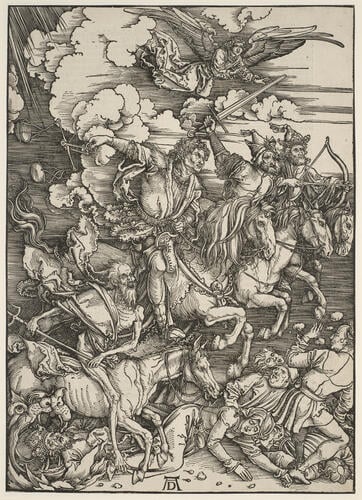-
1 of 253523 objects
Albrecht Dürer (1471-1528)
The Apocalypse: The Four Horsemen 1498
Woodcut | 39.7 x 28.5 cm (sheet of paper) | RCIN 800135
-
A woodcut from Dürer’s Apocalypse showing the Four Horsemen of the Apocalypse.
The Book of the Revelation of St John, commonly known as the Apocalypse, was a popular subject for illustration throughout the Middle Ages, series of images appearing in illuminated manuscripts, frescoes and, famously, a vast tapestry at Angers. The text, with its predictions of violent turmoil, became increasingly referred to in the approach to the year 1500, when it was widely believed that the world would end. In Dürer’s native city, the Nuremberg Chronicle of 1493 was published with blank leaves for readers to record the final events of an age that was believed to be coming to a dramatic close. Dürer’s vivid, and at times terrifying, woodcuts captured the fears of the age and the imagination of the market. The large number of surviving examples suggests a publication that was extremely popular.
Dürer’s Apocalypse was published as a book, with 15 full-page illustrations, each facing a page of text. This woodcut is from the first edition to be published, which was issued in 1498 with a German text. An edition with Latin text was issued in the same year. Some of the illustrations in Dürer’s Apocalypse were partly adapted from the German Bible which had been published in Nuremberg by his godfather, Anton Koberger, and Dürer also took the text and typeface from Koberger’s earlier publication. The Apocalypse was one of the first books to have been designed and published by an artist, and Dürer described himself in the colophon as Albrecht Dürer maler (‘painter’).
Dürer’s scenes are crammed into the space available, capturing the chaos and unrest of the Apocalypse text. Often two or three events take place within one illustration, and the backgrounds are rarely left plain white, but are filled with scudding clouds or rolling waves. Many of the scenes are crowded with incidental figures - witnesses who are dressed in contemporary clothes and with whom Dürer’s audience would have identified. At times the observers become victims: mown down by the four horsemen, cowering as fiery stars fall to earth, slain by avenging angels. They include members of all orders of society - bishops, children, soldiers, emperors - as a reminder that none would be spared the judgement expected when the prophecy was fulfilled. The Apocalypse was the first illustrated book to be produced by Dürer. Thirteen years later, in 1511, he would publish the so-called Large Passion and the Life of the Virgin, similarly popular religious texts which he could be sure would have broad appeal. In the same year he republished the Latin edition of the Apocalypse and also made the woodcuts available separately as single-sheet illustrations.
Catalogue entry adapted from The Northern Renaissance. Dürer to Holbein, London 2011Provenance
Probably in the Royal Collection by c.1728
-
Creator(s)
(designer) -
Medium and techniques
Woodcut
Measurements
39.7 x 28.5 cm (sheet of paper)
Category
Object type(s)
